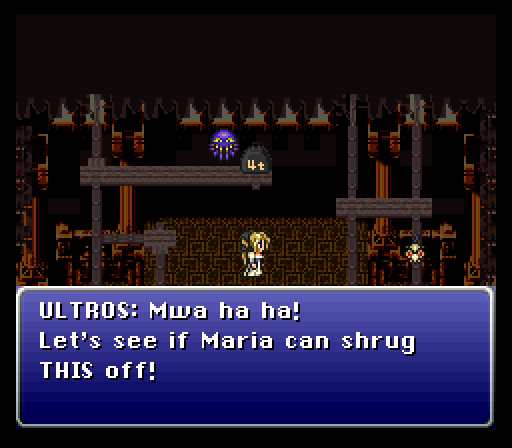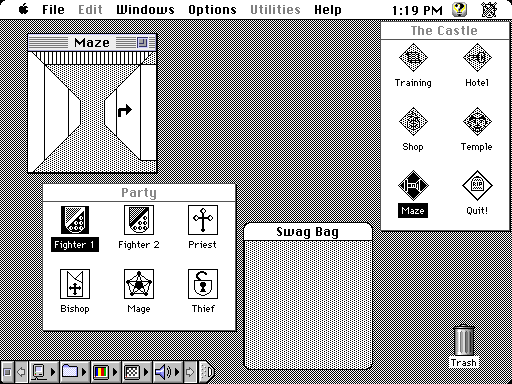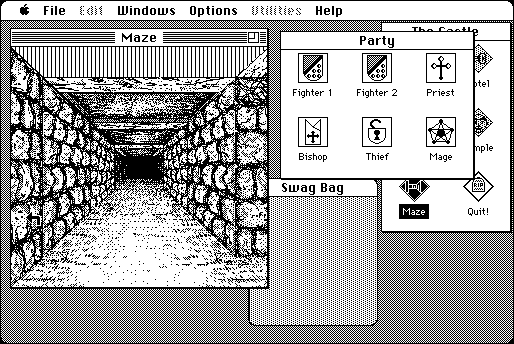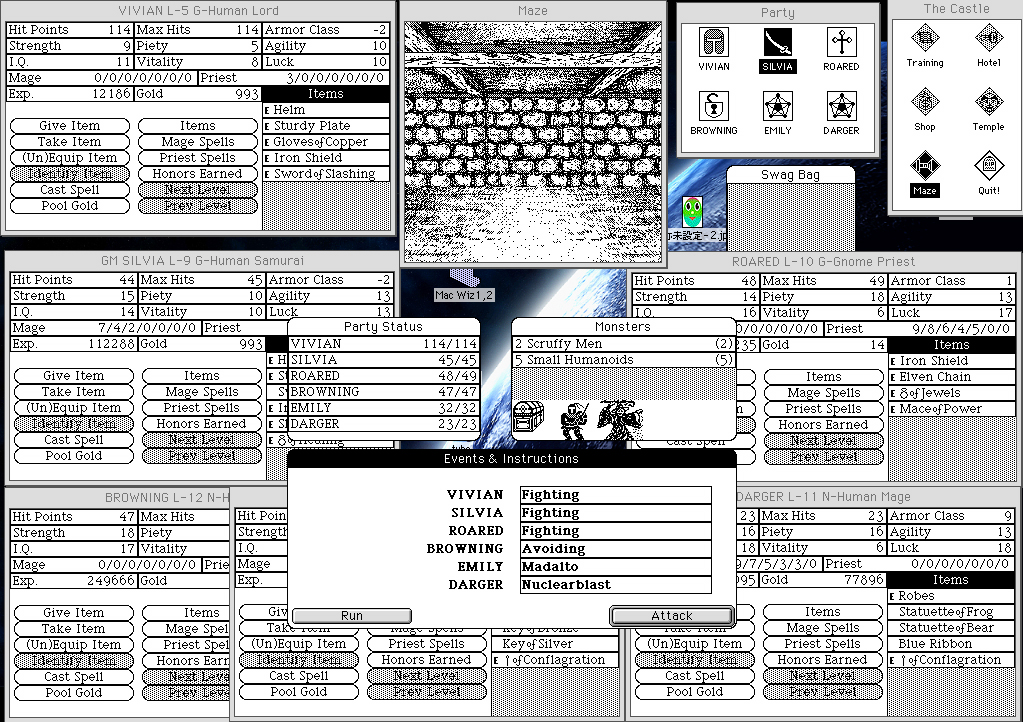When I first read about the Evercade, I didn't see much to get excited about — another retro gaming device with old Atari and Namco games you can already get in plenty of other places, and despite "-rcade" in the name it didn't actually have any arcade games, only console ports of them. Like, it might be something fun to get my nephew if it didn't cost quite so much, but I didn't think it was for me.
Times have changed. Those early Namco and Atari collections aren't really representative of where the Evercade is today — in fact, they've not even in production anymore.
Stuart Gipp's done a good job of covering the Evercade over at Retronauts; he's called attention to it as a system that often highlights weird or obscure retro titles, not just the obvious stuff. And when he interviewed a couple of the folks at Blaze Entertainment in an episode of the podcast, I decided I should probably get me one.
So I got three.
But I'll get to that in a future post. For now, let's talk about the Evercade.
Why (or why not) Evercade?
The Evercade is a gaming device primarily focused on emulation and retro-gaming.
Thing is, there are plenty of those. I have an Analogue Pocket. Hell, I've got a Steam Deck, which isn't emulation-focused but is pretty damn great as a handheld emulation device. Those both cost a lot more than the Evercade, but you can get an Abernic handheld around the same price point and load it up with ROMs.
So what sets the Evercade apart?
Does going legit matter to you?
I'm going to leave aside the indie games and native ports for now (we'll get to them down at the bottom) and just talk about the retro ROMs you can buy for Evercade.
You can find all these ROMs on the Internet. You want a complete dump of every NES game or whatever, they're not hard to find.
But a lot of the retro games on Evercade aren't available anywhere else legally.
Now, let's be real: in the vast majority of cases, buying 30-year-old games isn't going to support any of the people who actually worked on them. But you are showing the publishers there's a demand for games like these, and giving them an incentive to release more.
Does curation matter to you?
So these ain't exactly Digital Eclipse releases here. They are, for the most part (but not always!) pretty barebones collections of ROMs that, as I understand it, run in Retroarch. There's a description and box art for each game, you can use savestates and a few simple screen filters, and depending on which version of the Evercade you have, you may or may not be able to remap the buttons. (Which you will usually want to do, because the default mappings are mostly terrible.)
But nonetheless, people put thought into what to include in each collection. Most Evercade carts make for a pretty fascinating and diverse lineup of games from different times and different genres and, often, different systems. And, given the choice between multiple releases of the same game, the one they pick usually shows a certain amount of care — for example, as Gipp notes, Interplay Collection 1 has the Genesis version of Earthworm Jim, but Interplay Collection 2 has the SNES version of Earthworm Jim 2. They chose the better version of each game. Similarly, Sunsoft Collection 2 includes the Genesis version of Aero the Acro-Bat 2 and the SNES version of Zero the Kamikaze Squirrel.
It's easy to find a dump of every SNES game ever released. But what are the odds you'll fire it up, look through the list, and say "Hey, Zero the Kamikaze Squirrel sounds like fun; I'll play that one"? I've scrolled through those lists of Every Game, man, and it's like indecisively paging through Netflix for half an hour: too many options can make it hard to choose one. There's a value to a limited set of suggestions. Particularly if all the options are good, or at least interesting.
B-listers and deep cuts
Most dedicated retro-gaming devices focus on the hits. And the Evercade's got some of those — one of its upcoming devices is Street Fighter 2-branded — but it's also got collections where the most recognizable games are Earthworm Jim, Glover, and Dizzy.
And don't get me wrong, I love me some Mario, Sonic, and Castlevania, and the first thing I did when I got my Evercade EXP was fire up Mega Man X. There's nothing wrong with playing the hits. But the Evercade collections have that thrill of discovery. I've never played Claymates before, and it turns out I've been missing out. I haven't spent enough time with Joe and Mac 2 yet to realize if it's any good, but it sure looks great. Even something like The Fidgetts, which I wouldn't describe as good, has some lovely sprite work and is so close to being good, if only it weren't for oldschool artificial-difficulty mechanics like lives and a way-too-short timer. Even the games that aren't great are worth the time to check out, and I doubt I ever would have if they hadn't come in collections like these.
How do you feel about physical media?
Well, they've got their benefits and drawbacks, don't they? On the one hand, they'll probably still work in 30 years if you still have the hardware. On the other, they sure do take up space, and obviously it's less convenient to swap cartridges than to just pick a game from a menu.
Evercade games come on cartridges, in plastic clamshell cases, with full-color manuals. That's pretty cool! But maybe not the most convenient. But it brings us to:
The collector thing
It doesn't take long to figure out that the Evercade is a system for collectors.
I wouldn't say I'm a collector on purpose, but I definitely collect things — if for no other reason than I'm terrible at getting rid of the shit I have.
I've got a comic collection, a game collection, a movie collection; I'm a collector. But I buy comics to read them, games to play them, movies to watch them — sure, I've got a backlog, but I mostly don't buy stuff just for the sake of having it. I don't worry about gaps in my collection — sure, occasionally I'll think "Hey, I'm only one issue shy of a complete run of Simpsons Comics," but then I forget about it; I don't go on eBay and start looking for it because I just have to complete my collection.
But yeah, the Evercade encourages collectors; it's got numbered releases, a menu screen that keeps track of which games you have and which ones you're missing, the whole deal. The good thing about this is, if you buy a used Evercade game, it's probably going to be complete and well-cared-for. The bad thing is, once games go out of production they start to get expensive. You want a copy of the Oliver Twins Collection? It ain't gonna be cheap.
Since getting an Evercade, there have definitely been a couple of times I've seen an announcement that a cartridge has been discontinued and then thought "Oh shit, I'd better get that while I still can." And sometimes that's a good idea! I got the Codemasters Collection while it was still available for $20 new, and there are some great games on that thing. But it can be easy to get caught up in that mentality and spend too much money on stuff you don't need if you're not careful.
If you like to collect things, the Evercade will scratch your itch. Just don't go overboard, okay?
The unique stuff
Now, I've said that most of the retro collections are just simple ROM dumps, and that's true, but it's starting to change.
First there were modest modifications, like removing Charles Barkley from Barkley Hoops: Shut Up and Jam.
More recently, there have been ground-up remakes: this year's Piko Collection 4 includes Glover, which the Evercade site describes as "rebuilt from scratch" to run smoothly on a device that isn't exactly optimized for N64 emulation. And the collection that convinced me to buy an Evercade in the first place, Duke Nukem Collection 1, includes remakes of the first two games.
You can buy Glover on Steam. You can find Duke Nukem 2 on abandonware sites. But these specific versions of those games aren't available for any other platform but Evercade. A lot of work went into them, and they're pretty fucking cool.
And the indies
So now let's get to the indies.
They're fucking great.
If you have an Evercade EXP or VS, there's a featured indie game every month; you download it and you can play it for free until they replace it with the next one. And periodically they'll release compilations of indie titles, including those previously-featured downloads as well as others. And they're some of the best games on the system.
Some of them are modern ROMs for retro systems that run in emulators; some are retro-style games designed for modern systems and ported to run natively on the Evercade. In both cases what we've got are some games that look, sound, and feel like old 8- or 16-bit classics, but with another thirty to forty years of design iteration.
And once again, you've got other options for devices to play these games on — legally, even. Most of them are on Steam or itch.io or direct from the publisher's site. They're not necessarily a reason to get an Evercade in themselves.
But if you do buy an Evercade, you'd be remiss in not checking out at least some of them. It's a device whose primary purpose is playing old games, but the best games on it may very well be the new ones.
My current favorites are Alwa's Awakening, Full Void, and Tapeworm Disco Puzzle.
So that's a quick introduction to the Evercade. Next time I'll talk about the different models I've tried (and some I haven't) and where to buy (I like videogamesplus.ca). Join us, won't you?







